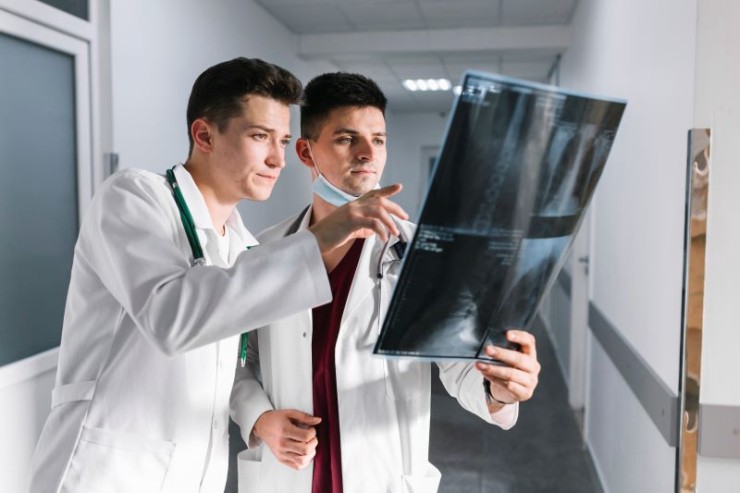
The PET-CT Bone Scan combines the strengths of Positron Emission Tomography (PET) and Computed Tomography (CT) to provide a comprehensive evaluation of bone structure and metabolic activity.
PET-CT Bone Scan in India with Cost
PET-CT Bone Scan in
Detail: Unveiling Skeletal Health with Precision Imaging
In the realm of diagnostic imaging, the PET-CT Bone Scan emerges as a powerful tool for assessing bone health and detecting abnormalities. This comprehensive guide aims to elucidate the significance, procedure, and applications of the PET-CT Bone Scan, offering a detailed understanding of its role in modern healthcare.
Introduction
The PET-CT Bone Scan combines the strengths of Positron Emission Tomography (PET) and Computed Tomography (CT) to provide a comprehensive evaluation of bone structure and metabolic activity. This advanced imaging technique is instrumental in detecting bone-related conditions and guiding appropriate medical interventions.
Understanding PET-CT Bone Scan
Positron Emission Tomography (PET):
PET involves the administration of a radioactive tracer, typically fluorodeoxyglucose (FDG), which is absorbed by cells with high metabolic activity, such as cancer cells. In the context of bone scans, PET highlights areas of increased metabolic activity in the skeletal system.
Computed Tomography (CT):
CT imaging provides detailed anatomical information about the bones, showcasing their structure, density, and any signs of abnormalities or lesions.
Importance in Bone
Imaging
The PET-CT Bone Scan holds paramount importance in various aspects of bone health:
Cancer Detection and Staging: Essential for
identifying and staging bone metastases associated with various cancers.
Bone Infection Diagnosis: Aids in
detecting bone infections or inflammatory conditions affecting the skeletal
system.
Evaluation of Bone Disorders: Provides
insights into bone disorders, such as fractures, arthritis, or degenerative
conditions.
Preparation for PET-CT
Bone Scan
Preparation for a PET-CT Bone Scan typically involves:
Fasting: Patients may be required to fast
for a specific duration before the scan for optimal imaging results.
Hydration: Adequate hydration is encouraged
to enhance tracer distribution in the body.
Procedure: Mapping
Skeletal Metabolism
Radiotracer Administration: The patient receives
the radioactive tracer, often FDG, intravenously.
Uptake Period: The tracer is given time to
circulate and be absorbed by bones, particularly areas with increased metabolic
activity.
PET and CT Imaging: The combined
PET and CT scanner captures detailed images, providing a comprehensive view of
both bone structure and metabolic activity.
Assessment Areas in
PET-CT Bone Scan
The PET-CT Bone Scan is employed to assess various aspects of skeletal health, including:
Cancer Metastases: Identifying and
staging bone metastases associated with cancer.
Bone Infections: Detecting signs of bone infections
or inflammatory conditions.
Bone Disorders: Evaluating structural
abnormalities, fractures, arthritis, or degenerative conditions.
Benefits of PET-CT Bone
Scan
Comprehensive Imaging: Offers a comprehensive
assessment of both bone structure and metabolic activity.
Early Detection: Facilitates early detection and
staging of bone-related cancers and disorders.
Treatment Planning: Assists
healthcare providers in planning appropriate treatments based on the scan
results.
Risks and Considerations
The PET-CT Bone Scan involves exposure to low levels of radiation from both PET and CT components. However, the benefits of accurate bone assessment generally outweigh the associated risks.
Clinical Applications
PET-CT Bone Scans find applications in various clinical scenarios, including:
Oncology: Crucial for cancer staging and
monitoring treatment responses.
Orthopedics: Aids in evaluating fractures,
arthritis, and degenerative bone conditions.
Expert Perspectives
Oncologists, orthopedic specialists, and nuclear medicine experts collaborate to interpret PET-CT Bone Scan results, providing comprehensive insights into bone health.
Technological Advancements
Continual advancements in imaging technology contribute to the refinement of PET-CT Bone Scans, enhancing image resolution and diagnostic capabilities.
Patient Experience
While PET-CT Bone Scans involve exposure to radiation, they are generally well-tolerated by patients. The procedure provides valuable information to healthcare providers without invasive measures.
Conclusion
In conclusion, the PET-CT Bone Scan stands as a pivotal imaging modality, offering a comprehensive evaluation of both bone structure and metabolic activity. Its applications in cancer detection, bone infection diagnosis, and the assessment of various bone disorders contribute to advanced and personalized healthcare for individuals with skeletal concerns.
Frequently Asked Questions (FAQs) related to PET-CT Bone Scan
1. Is a PET-CT Bone Scan painful or uncomfortable?
No, the PET-CT Bone Scan itself is not painful. The injection of the radioactive tracer may cause a brief sensation, similar to a standard injection. The imaging procedure is generally comfortable, and patients are required to lie still during the scan.
2. How long does a PET-CT Bone Scan take?
The duration of a PET-CT Bone Scan varies, but the imaging process typically takes about 30 to 60 minutes. It may take additional time for preparations and the injection of the radiotracer.
3. Are there any specific risks associated with the radioactive tracer used in PET-CT Bone Scan?
The amount of radiation from the radioactive tracer is generally considered safe, and the benefits of the scan usually outweigh the risks. However, pregnant women and individuals with certain medical conditions may need to consult with their healthcare provider before undergoing the scan.
4. Can I eat or drink before a PET-CT Bone Scan?
Fasting may be required for a certain period before the scan, especially if FDG is used as the radiotracer. Your healthcare provider will provide specific instructions based on the type of tracer used.
5. How do I prepare for a PET-CT Bone Scan?
Preparation may involve fasting, staying well-hydrated, and sometimes adjusting medications. Follow the instructions provided by your healthcare team to ensure optimal imaging results.
6. Can a PET-CT Bone Scan detect all types of bone abnormalities?
PET-CT Bone Scans are particularly effective in detecting cancer-related bone abnormalities and metabolic activity. However, certain structural details may require additional imaging methods, such as conventional X-rays or MRI.
7. Are there any side effects of the PET-CT Bone Scan?
Side effects are generally minimal. Some individuals may experience mild discomfort at the injection site or have an allergic reaction to the radiotracer. It's crucial to inform the healthcare team of any allergies or adverse reactions to previous imaging procedures.
8. How often should a PET-CT Bone Scan be repeated?
The frequency of PET-CT Bone Scans depends on the specific medical condition being monitored. Your healthcare provider will determine the necessity and timing of follow-up scans based on your individual case.
9. Can PET-CT Bone Scan be used for conditions other than cancer?
Yes, PET-CT Bone Scans are valuable for assessing various bone-related conditions, including infections, inflammatory disorders, and certain orthopedic issues. The versatility of the scan allows it to be used in different medical contexts.
10. Are there any age restrictions for undergoing a PET-CT Bone Scan?
There is no strict age limit for a PET-CT Bone Scan. The appropriateness of the scan is determined based on the individual's health status and the clinical indications for the imaging procedure.
These FAQs aim to provide additional information and address common inquiries related to PET-CT Bone Scans. Always consult with your healthcare provider for personalized guidance and information tailored to your specific situation.
(0)
Login to continue



